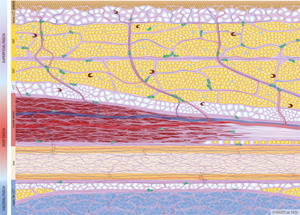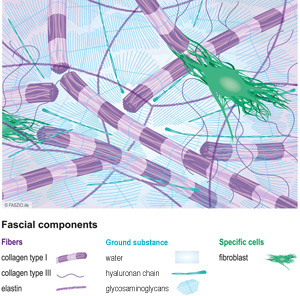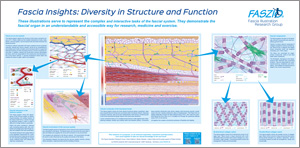Fascia Insights: Diversity in Structure and Function
Fascia illustrations for download

Fascia Illustration Research Group:
Miriam Wessels, Heike Oellerich, Juliane Galke
All illustrations offered here have been developed with lots of research diligence, tireless enthusiasm and the friendly support of Robert Schleip of the Fascia Illustration Research Group.
These graphics serve to illustrate the complex and interactive tasks of the fascia system for research, medicine and sports. For the first time they show important sub-areas of this exciting tissue in a detailed, vivid and cutting-edge way.
We thank the Fascia Research Society for the presentation at the Fascia Research Congress 2022 and fascia luminaries Gary Carter, Peter Friedl, Stuart McGill, J.C. Guimberteau, Werner Klingler, Helene Langevin, Thomas Myers, Yuval Rinkevich, Carla Stecco, and Jan Wilke for their time, advice and appreciation.
 • Fascia illustration: Fascial continuity of the functional levels
• Fascia illustration: Fascial continuity of the functional levels
This fascia graphic shows the three fascial functional planes (superficial, deep and visceral) that are formed and connected within the fascial network. Because of fascial continuity, each level acts independently while being a remaining part of the three-dimensional fascial network with body-wide interaction.
Loose connective tissue (LCT) enables all structures to slide against each other, allowing interplay, transfer and mobility within and between planes. Connective tissue strands (retinacula cutis) anchor deeper solid structures (periost, myofascia) to the skin, thereby limiting the radius of displacement. Their fibers first run slightly diagonally through the deep adipose tissue (DAT), then meet the superficial fascia and from there run in a straight line through the superficial adipose tissue (SAT) to the dermis.
All together this creates a functional symbiosis of flexibility and stability.
> buy usage rights for illustration “Fascial continuity of the functional levels” here
 • Fascia illustration: Fascia as an eco-system
• Fascia illustration: Fascia as an eco-system
This fascia graphic depicts the structure of the loose connective tissue (LCT). Clearly visible are the multiple interactions of cells, metabolism, immune system, nerve functions with and within this fluid-rich fascial structure.
The fibrous network saturated with basic substance forms lymphatic channels, arterial and venous vessels, serves as an embedding for nerve fibers and is both a location and a transport path for supply and disposal functions of cells (including immune, fat and connective tissue cells). In addition, special cell construction workers (fibroblasts) act there, which are responsible for the construction and deconstruction of the tissue network. A vacuole architecture stores water and enables the tissue to glide, deform and stabilize.
> buy usage rights for illustration “fascia as an eco-system” here
 • Fascia illustration: Fascial components
• Fascia illustration: Fascial components
This fascia graphic focuses on the generally relevant components and uses simplifying general terms.
Fascia is a tissue network composed of collagen (resistant to traction and tearing, can rebound like a catapult) and elastin (loose connection which can lengthen reversibly up to 150%) fibers.
The fibers are connected by sugar-protein compounds, which in turn bind water (basic substance).
The fibroblasts, belonging to the fascia, produce fiber elements and connecting proteins. They are responsible for a permanent build-up, breakdown and remodeling. This enables the fascial tissue to adapt to the current requirements.
> buy usage rights for illustration “fascial components” here
 • Fascia illustration: Parallel-fibred collagen matrix
• Fascia illustration: Parallel-fibred collagen matrix
This fascia graphic shows the parallel course of collagen type I fibers, which is found in tissue structures that require strong tensile strength (e.g. tendons, ligaments). Various connecting proteins provide the arrangement, fluidity and functionality.
> buy usage rights for illuastration “parallel-fibred collagen matrix” here
 • Fascia illustration: Bi-directional collagen matrix
• Fascia illustration: Bi-directional collagen matrix
This fascia graphic shows the bi-directional course of collagen type I fibers found in tissue structures with multidirectional radius of motion and volume changes (e.g. muscle bodies, organ sheath). Connecting proteins ensure the arrangement, fluidity and functionality.
> buy usage rights for illustration “bi-directional collagen matrix” here
 • Fascia illustration: Fascial relevance in the immune system
• Fascia illustration: Fascial relevance in the immune system
This fascia graphic shows the dependence of the immune system on fascia. Superordinately, the surface tension of the fascia itself forms a barrier through its electrical charge in order to make it difficult for foreign bodies to penetrate.
Within the basic substance, defense cells (including plasma cells, their antibodies and phagocytes) fight foreign bodies and antigens that have penetrated.
The fascial transport and supply feature is the regulative requirement for a well-functioning immune response as well as for cell recycling (autophagy) by recognizing, breaking down and utilizing the cells own components.
> buy usage rights for illustration “fascia as an immune system” here
 • Fascia illustration: Fascial involvement of the nervous system
• Fascia illustration: Fascial involvement of the nervous system
This fascia graphic gives an impression of how close the nerve and its functions are connected to the fascia. The fascial tissue not only forms the nerve bed, it also permeates and supplies the nerve and connects it to its environment.
The receptors are stretched in the fibrous network. The transmission through the axons is also influenced by the quality and lubricity of the fascia.
The interaction between the fascia and the nervous system controls, among others sensation, responsiveness and the handling of stress.
> buy usage rights for illustration “involvement nervous system” here
 • Fascia poster: Fascia insights – diversity in structure and function
• Fascia poster: Fascia insights – diversity in structure and function
> buy usage rights for “fascia poster” here


